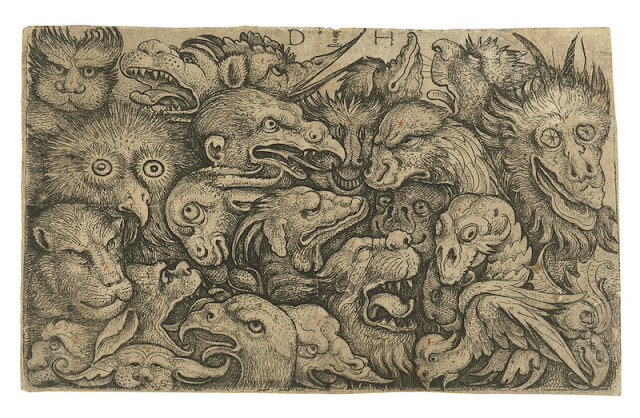There's a whole gallery of Wolverton's wonderful Rubber Ugly designs, both used and unused, here, and huge thanks to Nils for posting this and for constantly updating our Further Research Into Hideous Fun. I've been trying to think more meatily about this subject though recently, the role of monster design in our great big collective unconsciousnesses, ever since I was asked months ago while banging on about Frankenstein, or maybe King Kong, or probably both: "What are monsters for?"
"Hoppin' Cretins" - another of Nils' finds.
I'd been thinking a lot at the time about monsters as symbols of isolation - Sesame Street was populated by monsters specifically because the message of that show is "nobody is the same" - but I also rolled out to my friend all the usual stuff about monsters as a metaphor for challenge, and also as just things that were fun to draw. I was all over the place, in other words.
One of Peter Klúcik's unpublished "Hobbit" illustrations,
posted on today's ever reliable Monster Brains blog.
So I thought it might help if I started talking about Buffy the Vampire Slayer, but they hadn't seen it. Then they started talking about The Trap Door, in almost exactly the same terms I'd been trying to explain Buffy (and with an enthusiam I'd never seen them discuss any work of fiction previously), and - well, I was going to say "we left it at that", but we clearly didn't because they're now reading Frankenstein, and I'm writing this. But in trying to categorise the differing uses of "monsters" I think,
tonight, I might have actually, finally hit upon something.
"Heads of Grotesque Animals" by Daniel Hopfer, 1505-36, again from Monster Brains
As a starting point, I thought it would be worth distinguishing between monsters that were unseen "bogey men" - the monsters out there: Grendel, Alien, things that go bump in the night, personifications of a primal fear of the dark - and monsters that existed in clusters and were simply fun to draw: Wolverton's Uglies above, or the muppets in Labyrinth, or the demons depicted in medieval and renaissance paintings of Sin...
"St. Christopher Carrying the Christ Child through a Sinful World" Monster Brains again
... Or indeed whatever the narrator in today's Defoe imagines seeing through a microsocope when he writes of "strange, monstrous, and frightful shapes, such as dragons, snakes, serpents, and devils, horrible to behold" - monsters, in other words, that were always with us. But as soon as I set that division down I realised the categories didn't work, because demons and germs are just as unseen as the monsters out there in the dark. And then I realised, that's the point. Whether it's H. R. Giger's Alien design, or the plasticine critturs from The Trap Door, or Hoppin' Cretins, or Rangda the demon queen...
Or these guys...
Or these guys...

And I recognise all I've done here is go a very roundabout way to arriving at the most obvious starting point for talking about Horror that there is, but it feels good to have made the journey. Anyway here's today's Defoe. If you only want to hear how people in the seventeenth century tried to test people for the plague (one method involves chickens) you can go straight to 13:57...
TOMORROW: What all this has to do with Mos Eisley.







Not entirely on topic, probably, but would you say faeries, goblins, mermaids, and suchlike (the sort of mythical beings that belong in traditional folklore, rather than their Disney animation/modern fantasy adaptations) should be categorised as 'monsters', or do they fall into a separate, non-monstery category of legendary creatures?
ReplyDeleteDefinitely definitely monsters. Pretty much the definition of monsters, I'd say.
ReplyDelete